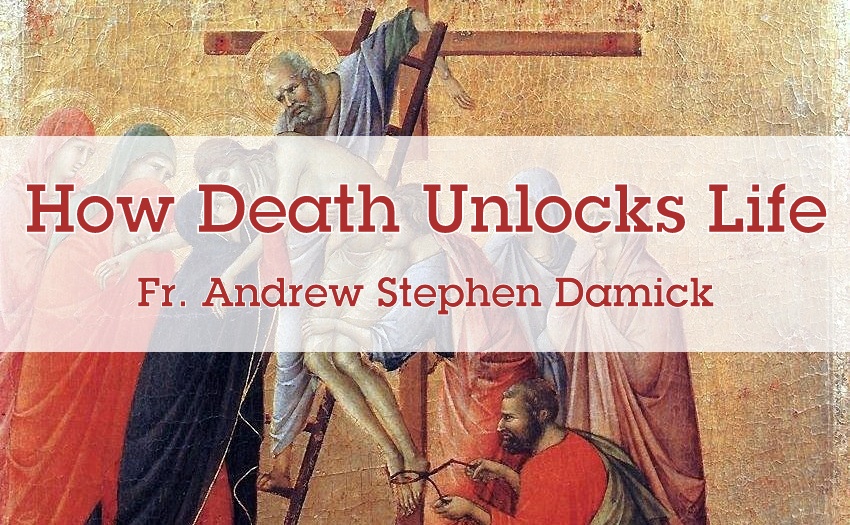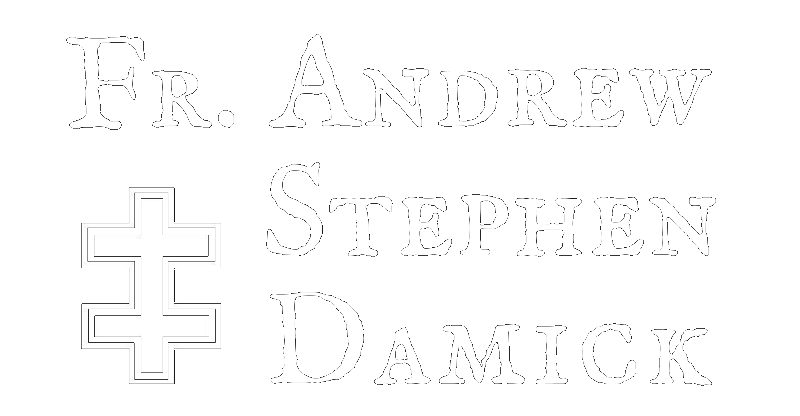
Myrrh-bearers Sunday, May 15, 2016
Acts 6:1-7; Mark 15:43-16:8
Rev. Fr. Andrew Stephen Damick
In the Name of the Father and of the Son and of the Holy Spirit, one God. Amen. Christ is risen!
Today on this third Sunday of Pascha, we return for a little while to a precious moment in Holy Week, when on Holy Friday and Saturday we encounter the mystery of the very body of the God-man Jesus Christ being taken down from the cross, wrapped in fine linen, anointed with burial spices and then placed in a new tomb hewn out of rock.
Whoever has been present for these wonderful divine services cannot forget the sweetness and care and love of the women who, in the company of His holy mother, followed Jesus closely, stood with Him at the cross, and were present as He was laid in the tomb by Joseph of Arimathea and Nicodemus. And we also cannot forget the honor paid the Lord by those two men who received the body from Pilate and actually took it down from the cross. And Joseph even places Jesus in his own tomb, as though He were a member of his own family.
When there has been a death, especially of someone who is beloved, this is what naturally and properly happens—family and friends gather together and surround the body, caring for it, caring for each other, mourning together, connecting together. I thought of this myself recently as a little over a week ago I gathered with seven other clergy to wash and anoint the body of Fr. Ted, and then to vest him in his liturgical vestments.
I know that this is a favorite moment in Holy Week for many of us, when the icon of the body of our Lord is taken down from the cross, and we wrap it in a winding sheet, taking care of Him ourselves in a mystical way, joining our love and piety to that of the Myrrh-bearers, Joseph and Nicodemus by doing for Him what they did for Him. This church service draws us together in a very powerful way. And we experience the same thing at a funeral for one of our own departed, as well.
Death should draw a family together, and in it we express our emotions, our love and our common memory, joined together by a bond that can compel even the hardest of hearts to show love. Often, in the midst of these times of transition, where the world seems turned upside-down, relationships that had been locked into dysfunction or disuse, can loosen up and become flexible again, bearing in that moment the possibility for a new way of connecting with each other, a new path to walk that before was invisible.
And this doesn’t happen only with death, by the way. This also happens with births and with weddings, with all of these great transitions in life.
The disciples had gotten locked into their view of Who Jesus was and what He meant for their future. Some of them were still even asking if He was going to restore the kingdom to Israel, that is, the political independence of the Jews from the Romans. Their imaginations were stuck in another way of seeing things. They couldn’t understand what Jesus had really come to do.
Death can be shocking, and people can sometimes do extreme things when a death occurs or is in process. Most of the twelve disciples of Jesus (except John) abandoned Him. Peter denied Him three times, and of course we remember that Judas who had betrayed Jesus went out and hanged himself. Yet these two men, Joseph and Nicodemus, and His mother along with several other women, stayed with Him and minister to Him even after His death and His burial.
In time, the other disciples would come back to Jesus after His resurrection, including a very public restoration of their leader Peter, who had denied Jesus three times. In the meantime, these more peripheral followers of Jesus would show them the way. While the disciples were scattered and paralyzed, these women and these two men were there in the middle of everything, even at risk to themselves, doing what was needed in piety and love.
The Myrrh-bearers, Joseph of Arimathea and Nicodemus maintained that non-anxious presence in the midst of the community that had surrounded Jesus, a community that had been thrown into disarray. By keeping their peace and remaining faithful, these few opened up the path for those who had been so shaken by the death of Jesus. They provided a non-reactive way for those who had followed Jesus and had gotten stuck in their emotional and spiritual processes to become unstuck and to see a different way.
We therefore gather together today with the Lord’s mother, with the Myrrh-bearers, with Joseph and Nicodemus, all around the body of the Lord Jesus. We take Him down from the cross. We lay Him in Joseph’s tomb.
And to our surprise and our delight, we find that that same body which was dead is now alive. That same body which was dead is now deified and glorious. That same body which was dead is now seated at the right hand of the Father. That same body which was dead has become our very food and drink. That same body which was dead is now the source of life. That same body which was dead imparts to us immortality.
When we experience death or other major life transitions, we have an opportunity to remake our own emotional and spiritual processes. We have the chance to examine how we have been living, to see where we have gotten stuck, to be critical of ourselves and see plainly what our brokenness truly is and how it is keeping us from loving God and each other.
This is true both in the case of the deaths we experience of those close to us and also in the death that we each experience in Lent and Holy Week every year. And here I mean both the death of Jesus Christ and also the death of our own ego that Lent is designed precisely to bring about. We are plunged into a time of brokenness and mourning for several weeks, brought finally to that awful moment when we see our Savior hanging crucified on the cross. And brought also to that painful moment when we ourselves are also crucified with Him.
And why are we given over to death? Why do we keep returning to this place of the death of Jesus, the deaths of ourselves, and at other times, the deaths of those around us, both at the actual moments and in subsequent memorial services?
It is not only so that we remember that death comes to us all. Of course we should remember that. It was remarked more than once by those priests who gathered around Fr. Ted to anoint and vest him that someday, that would be each of us. We cannot forget that the remembrance of death can be a powerful motivator toward putting our lives in order.
But there is something much deeper here. When death happens, everything comes unstuck. Everything comes unlocked. What has been deadlocked and gridlocked now is released. All the doors are opened. All the chains are thrown off. All the vicious cycles are broken up.
With death, we have an opportunity—the opportunity to be remade. With death, old ways of unhealthy thinking and relating can be replaced by new ways that lead to healing and growth. We have the opportunity to begin again, to be cleansed and renewed, to turn our unfaithfulness into faithfulness, to turn our resentment into forgiveness, to turn our estrangement into reconciliation, to turn our hardness of heart into love.
Why does that work? It is because death has now been infused with the power of resurrection. Death will never be the same again, not after the death and resurrection of Jesus Christ. And why does this also work at births and weddings and other times of transition in life? It is because each of those moments is for us a kind of death, where things will never be the same again. The old way of living is gone. And with these changes comes a new opportunity to come unstuck. Death unlocks life.
And that is why we venerate today these Holy Myrrh-bearing women, Joseph of Arimathea and Nicodemus, because in the midst of the disarray of death and the shock of having all their expectations destroyed, these people showed another way, a way of peace and healing that became the way, too, of the disciples of Jesus, so that they would become His Apostles, His missionaries to the world.
And we also now hear the voice of the angel: “Do not be amazed; you seek Jesus of Nazareth, Who was crucified. He has risen, He is not here; see the place where they laid Him. But go, tell His Disciples and Peter that He is going before you to Galilee; there you will see Him, as He told you.”
To the risen Lord Jesus Christ, with His Father and the Holy Spirit, be all glory, honor and worship, now and ever, and unto ages of ages. Amen. Christ is risen!




thank you
As a hospice nurse I suppose my role is to maintain that “non-anxious presence in the midst” of the dying experience –keeping as models Joseph of Arimathea, Nicodemus, the Theotokos, and the disciples who stayed by Christ’s side. A high calling indeed! Thank you for reminding me of it’s noble model. Death unlocking life and making possible a break from dysfunctional habits is a very positive outlook on death and dying. Well done!